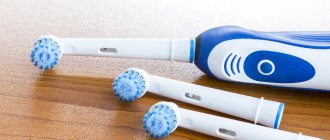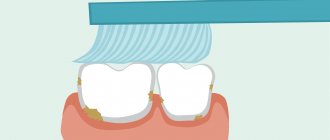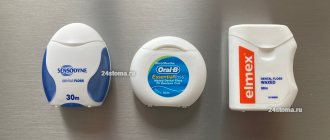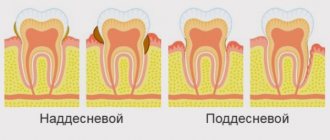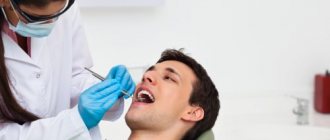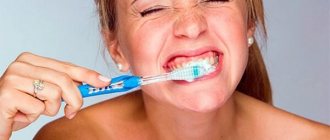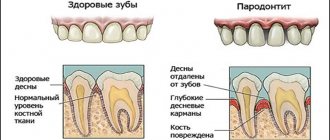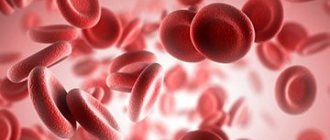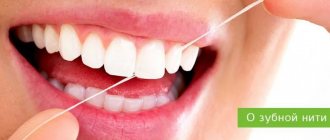Indications Advantages of use Contraindications How to use?
Dental floss and braces Types How to choose? If the floss gets stuck Brand rating For quality oral hygiene, just a brush with paste is not enough. Teeth have 5 surfaces, the brush effectively cleans 3 - anterior, lingual, chewing. The remaining 2 (cervical area, interdental spaces) need to be cleaned of plaque and food debris using additional hygiene products - dental floss or an interdental brush. And if, with dense interdental spaces, the effectiveness of a brush is in doubt, then the benefits of correctly chosen flosses are obvious. But many people don’t even know how to use dental floss correctly.
What is dental floss?
Floss is a special thread made of silk or polymer fiber for high-quality cleaning of the spaces between incisors, canines, premolars, and molars. It helps remove food particles in a similar way to a toothpick, but is much safer and more effective. The fibrous structure of dental floss makes it possible to gently and gently remove deposits from the enamel, preventing bacteria from multiplying and destroying hard tissue. The floss is placed between the teeth, cleaning first one side and then the other side of the dentition. It is important to know how to use dental floss correctly, otherwise the opposite effect will be obtained instead of benefit.
Flosser
For hygienic cleaning, in addition to regular thread, you can use a flosser - a device that makes the process more convenient and comfortable.
With the help of the device, winding the thread around your fingers is eliminated, and there is no need for special application experience. It is also called “handle floss”.
Two types have been developed:
- Flossette - designed specifically for those people who, due to special circumstances or age, cannot perform manual cleaning (for example, for older people or those who have special jaw structure).
In appearance, the device resembles a regular brush, but its bristles are replaced with a special thread. To process each tooth, it is necessary to always pull a new piece of thread onto it. This feature creates conditions for complete hygiene. Despite the ease of use, the device is expensive. It also cannot be replaced when the thread runs out, which means that after it is used up you will have to purchase a new one. - A flostik is a plastic frame with a stretched disposable nylon thread at the ends. The tip of the device is pointed and vaguely resembles a toothpick. It is easy to use because there is no need to open your mouth wide when brushing. It cleans well, but in the absence of experience in its use and some defects in the dentition, it can be traumatic.
Flostik is also an expensive device. Most people prefer to use it instead of thread only in special circumstances, such as in a cafe, restaurant or office.
Flosses have many differences from each other. But each of them is an excellent auxiliary device for maintaining teeth in good condition.
When to use floss
There are different recommendations for how to use dental floss. Some experts believe that it is more effective to apply it before hygienic brushing, while others believe that floss is more effective after brushing with paste. There is no general scientific basis or clinical studies on this issue. The only important thing is the systematic use of dental floss.
Direct indication for flossing:
- crowded teeth;
- installation of approximal fillings;
- periodontal diseases;
- the presence of any non-removable orthodontic (braces), orthopedic (crowns, dentures) structures.
To maintain healthy teeth and gums, hygienic cleaning should be performed 2 times, daily, morning and evening. Flossing is part of oral hygiene. This product will finish the job where you can’t reach with a brush. Dental floss is recommended for everyone, without restrictions on age or structural features of the dental system. Flossing is needed for milk teeth, permanent teeth, and artificial teeth (crowns, dentures).
Do rinses help?
Mouthwash is not part of the mandatory care products, but it is very popular. Some people buy mouthwash without thinking about the effect it should have. There are a number of indications for use:
- Gum diseases;
- Increased sensitivity of teeth;
Some also secrete liquid as a preventive measure for caries, but the choice of such products must be very careful, with a full study of the composition and the relationship to the current state of the oral cavity. Despite their refreshing taste, mouthwashes are not intended to improve breathing.
When choosing a mouthwash, you need to pay attention to the content of fluoride, alcohol and antiseptics like benzydamine. These points are decisive, since the presence of one or another component indicates a difference in indications for use. The fluorine content should not exceed 250 ppm, but even at an acceptable level it is necessary to comply with the paste, which, on the contrary, should not contain fluorine, but should contain calcium.
Liquids with an antiseptic cannot be used for more than a few weeks, because strong disinfectants kill not only pathogenic bacteria, but also the microflora of the oral cavity. The presence of alcohol indicates that this product should not be used by children.
How to use: instructions
To use dental floss most effectively, you need to know the correct cleaning technology:
- Pull out a part of the floss 45-60 cm long. This length is enough to securely fix the thread on your fingers. Also, each dental unit is processed with a new part, so it is more convenient to initially take a longer floss.
- Twist the ends of the thread around your index or middle fingers. Make several turns, leaving a stretched part about 3 cm long between the thumbs. This part will be used to clean the contact surfaces.
- Gently insert the floss into the interdental space. After several light forward movements, the thread is inserted just below the gingival margin. Carefully move it up and down between the contact surfaces, around the tooth, slightly penetrating under the cervical area. Do not tug or pull the thread so as not to damage the mucous membrane and gum tissue.
- A similar procedure is repeated for all adjacent teeth. Cleaning begins with the upper row of teeth, then cleans the lower one. They move from the central incisors to the edges, in one direction or the other. To develop a habit, you should clean the segments according to the same principle each time.
- Moving on to the next tooth, move the floss using a new, clean part. To do this, move your fingers, rewinding the used segment.
- After cleaning, rinse your mouth with warm water or a special product. This will get rid of food particles, plaque residues, and provide fresh breath.
Do not make cutting movements or insert the thread deep under the gum, avoiding damage to the dentogingival attachment. When everything is done correctly, there is no discomfort or pain. After processing the dentition, the used floss is thrown away. Repeated use will provoke the spread of pathogenic microorganisms in the oral cavity, inflammation and other problems.
The first few days after flossing, your gums may bleed slightly. With regular cleaning, the bleeding stops on its own. But if during hygiene you constantly find bleeding gums, you need to go to the dentist for an examination and diagnosis.
How to floss with braces
For braces, there are superflosses with hard tips that clean not only the contact surfaces of the enamel, but also the elements of the corrective equipment. They easily pass areas above/under the arch, around the locks. The floss is inserted over the arch into the interdental space. When the thread is in the correct position, use gentle up and down movements to clean the enamel surfaces. All other adjacent surfaces of the dental units are cleaned in a similar way. The thread is used after cleaning with a brush or brush. A special orthodontic needle threader will make threading over the wire easier.
Kinds
Modern threads are made from silk or polymer fibers (nylon, nylon, Teflon, acetate). Floss is sold in special cassettes (from 10 to 100 m), providing hygienic storage and comfortable unwinding of the required length, thanks to the cutting edge under the lid.
Manufacturers also offer threads on a holder (flosser, dental machine). They are sold in several units per package. Some people choose a flosser, since its use eliminates the contact of hands with the oral mucosa and makes caring for eighth molars (wisdom teeth) easier.
Advantages
Using floss allows you to achieve the following results:
- get rid of plaque and food residues that accumulate in hard-to-reach areas of the dentition;
- reduce the risk of developing caries;
- eliminate unpleasant odor from the oral cavity resulting from insufficiently thorough cleaning of teeth;
- maintain acid-base balance thanks to a variety of impregnations.
These points do not mean that you should abandon your toothbrush in favor of floss. Only a combination of these hygiene products can provide the most effective oral care.
What is the difference between dental floss?
Various types of thread are available for sale. Waxed, non-waxed, impregnated with silver, menthol, medicinal herbal extracts, as indicated on the package. Flosses are distinguished by cross-section, thickness, material, and processing.
According to sectional shape
- Round – recommended for large gaps between teeth;
- flat dental floss – efficiently removes deposits from crowded teeth and dense contact points;
- tape - for trema, diastemas.
By surface treatment
- Waxed - flosses treated with a thin layer of wax glide easily in the interdental space, are safe, suitable for gum disease, do not separate, simplify care;
- not waxed - they separate into fibers during use, the abrasive surface copes better with cleaning.
The difference between waxed and non-waxed dental floss is that the former penetrates between the teeth more easily, while the latter cleans the surface better.
By material
- Nylon - durable, strong, cleans contact surfaces efficiently, which makes them one of the most popular;
- silk dental floss - characterized by low mechanical tensile strength, therefore less and less are produced;
- nylon - reliable, strong, but less flexible than nylon models;
- acetate - elastic, soft, similar in characteristics to silk threads;
- Teflon - have the lowest coefficient of friction, quickly cope with dental plaque, the most expensive of all analogues.
All types of floss provide a similar effect. And the systematic, correct use of dental floss is more important than the brand, model or price.
How to choose
There are several main parameters by which dental floss is chosen. The first is size. The wider the interdental space, the larger the diameter of the floss needed. The second thing people pay attention to is the material, or rather the surface treatment. For beginners, it is better to choose a waxed thread, as it does not delaminate, easily enters the interdental space, and makes care easier. But floss without waxing removes deposits from hard-to-reach places better. People with braces and dentures should choose special models (superflosses), which do an excellent job of both cleaning between teeth and caring for elements of the orthodontic or orthopedic system.
Many patients are interested in what can replace dental floss. A good alternative is a flosser; it’s easy to use, you don’t need to monitor the length of the thread, and it’s easier to care for the outer teeth in a row. The irrigator does a better job of cleaning the periodontal sulcus, pathological pockets, and performs hydromassage of the gums, but it is not capable of cleaning the interdental spaces as efficiently as floss.
Contraindications
Not all people can benefit from this hygiene product.
Use is not recommended in the following cases:
- periodontal disease;
- bleeding gums;
- caries - there is a danger of sharp pieces chipping and threads getting into the wound;
- For crowns and bridges, you need to use special threads designed specifically for cleaning microprostheses.
The note. It is recommended to use dental floss after every meal. The minimum frequency of use is once a day during evening hygiene procedures.
What to do if the floss gets stuck
If dental floss gets stuck between teeth, you need to determine the cause. This happens if the size is incorrectly selected, if there are cracks, chips on the contact surface of the enamel or caries in this area. Another reason is tartar between the teeth, on which the floss clings, breaks, and as a result gets stuck.
To remove a stuck thread:
- rinse your mouth vigorously with water;
- rinse the interdental space with an irrigator;
- use a new thread to remove the problematic piece;
- use tweezers.
If these methods do not help, you should consult a doctor. Do not use needles, toothpicks, fishing lines, tines of forks or other sharp objects. This could result in serious injury. The dentist will remove the stuck piece quickly, without problems, using special tools.
Reviews
According to dentists, both standard dental floss and modern flossers can improve the quality of oral hygiene.
Correct use of these devices allows not only to remove bacterial plaque from the interdental space, but also to reduce the risk of stone formation and periodontal inflammation.
If you are used to using not only a brush, but also floss for oral hygiene, share your impressions in the comments section of the article.
If you find an error, please select a piece of text and press Ctrl+Enter.
